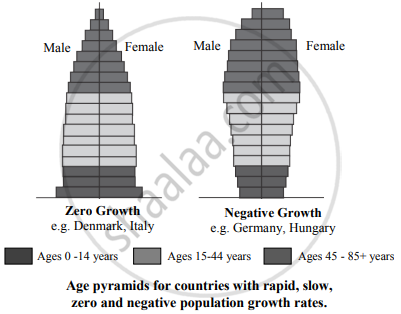Advertisements
Advertisements
प्रश्न
Define population growth. Explain different types of age pyramids.
उत्तर
Definition: The increase in the size of a population or increase in number of individuals is known as population growth. When resources in the habitat are unlimited, population show exponential growth. When resources in the habitat are limited, it leads to competition between individuals for limited resources. This type of population growth is called logistic growth
Age distribution and Age pyramids:
- A population consists of individuals with different ages. The entire population is divided into three age groups - prereproductive (0-14 years), reproductive (age 15-44 years), post reproductive (45-85+years)The relative proportion of individuals of various age groups in the population is referred to as age structure of the population.
- If the age distribution (per cent individuals of a given age or age group) is plotted for the population, the resulting structure is called as age pyramid.


संबंधित प्रश्न
What is mutualism?
Name the two intermediate hosts which the human liver fluke depends on to complete its life cycle so as to facilitate parasitization of its primary host.
Explain different population interactions with examples.
The relationship between sucker fish and shark is _________.
Mutualism can be represented as the interaction between ____________.
Exarch xylem is found in:
What is homeostasis?
The interaction between cattle egret and the buffalo is ______.
A Tight one-to-one relationship between many species of fig tree and certain wasps is an example of ______.
Write a note on parasitism.
